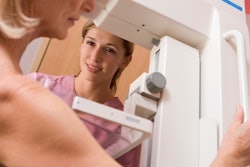
Groundbreaking Finnish research has shown that the long-term benefits of breast cancer screening in older age groups include lower incidence-based mortality and only a minor risk of overdiagnosis.
The study was unique in terms of its combined factors of target population size, wide age range of participants, and the duration of the follow-up, according to its researchers, who followed women in three different screening age groups -- 40 to 49, 50 to 59, and 60 to 74 -- as well as a postscreening age group of 75 to 84. The groups were followed for 23 years after national screening implementation in three residential areas: Turku, Helsinki, and the rest of Finland (RoF). The Finnish team also compared breast cancer diagnosis and age at death in the corresponding age groups and areas in the 11 years before screening implementation between 1976 and 1987.
Results showed that the wide mammography screening program in Turku was effective, especially in decreasing breast cancer mortality in the elderly age groups, supporting the implementation of screening in women up to 74 years of age (British Journal of Cancer, 17 February 2015).
The incidence of early-stage breast cancer increased and outcomes improved significantly due to screening, the study authors concluded. Statistics showed that mortality dropped in the elderly groups by 25% to 28% in the 23-year postscreening era depending on the age group and residential area. Overdiagnosis remained under 10% across the board in all age groups.
 Dr. Ilmo Parvinen is convinced that screening saves lives and must continue for women until they reach age 74.
Dr. Ilmo Parvinen is convinced that screening saves lives and must continue for women until they reach age 74."The study shows that estimations of 30% overdiagnosis in all [breast cancer] screening, as claimed by some screening critics, is not possible according to our results. The Finnish epidemiological calculations and registers show that it can't be true," lead author Dr. Ilmo Parvinen told AuntMinnieEurope.com.
Specifically, the study showed that in Turku, a city which represents 4% of Finland's population, an extension in the age range of the target population at national implementation led to even more striking long-term benefits. Instead of solely inviting women between 50 and 59 years of age as in the rest of Finland, the screening program in Turku invited women from 50 to 74 years of age to be screened every two years and also one or three years for women who were 40 to 49 years old.
This age extension was due to the perseverance and belief in the efficacy of screening among the region's female politicians and local health officials when screening was implemented nationally in 1987, according to Parvinen, who was one such official involved.
A general practitioner and health administration expert by training, he spent 18 years as head of Turku City Healthcare, followed by 10 years until 2010 at the Finnish Innovation Fund, SITRA, a self-funding governmental body, for which he is still an emeritus business director.
"Because the benefits of screening often become apparent 10 to 15 years later, the results showed that in the oldest postscreening age group in Turku, women 75 to 84 years of age benefitted from regular screening that had continued until they were 74," Parvinen said.
In Turku, incidence-based mortality dropped by more than 20% during 1987 to 2009 among women 60 to 74 years old at diagnosis compared with women in Helsinki and also in women 75 to 84 years old at death compared with women in the rest of Finland.
Although the study's results were scientifically validated in the older age group of 60 to 84, the 40- to 49-year age group of women who underwent screening every one or three years in Turku also showed an interesting drop in incidence-based mortality of 3% to 27%, Parvinen noted. Actual crude incidence-based mortality reduced by 50% in this age group in the years 1998 to 2009 (compared with the prescreening years 1976 to 1986); however, the statistical impact of the results was weakened by a small female population.
Turku's 60- to 74-year age group maintained a stable and relatively low incidence-based mortality. This was probably in part because these women had benefitted from palpation-based mammography screening in the prescreening era prior to 1987, he added.
All these results, which rely heavily on the longevity and thoroughness of the Finnish cancer registry and the dedicated and painstaking work of the research team, refute other research that suggests that there are no long-term benefits of screening in any age group, stated Parvinen, who points out that the results of this Finnish study are in line with original Swedish and U.K. randomized controlled trials.
"One of the most important study results was that there was no extensive overdiagnosis in Turku over the wide and long-lasting screening period. This means that the trend-based estimations of some scientists seem to be more or less invalid and give an unfair message to women internationally," he said.
Parvinen underlined the excellent participation in mammography screening in Finland -- at 86.7% during 1992 to 2009 (Finnish Medical Journal, 2013, Vol. 68, pp. 225-231), 40.7 million women years analyzed, and the unprecedented length of a 23-year follow-up of screened patients, all factors which increased the validity of the results.
"The results are drawn from homogenous, multiresidential areas and age groups with known prognostic background variables, but at the same time with similar treatments and participation rates. These types of results with urbanized (Helsinki) and rural (RoF) references may also be considered more reliable than study results drawn from nonhomogeneous populations vulnerable to bias" (BMJ, 15 April 2004, Vol. 328, pp. 921-924 and 28 July 2011, Vol. 343, p. d441; New England Journal of Medicine, 22 November 2012, Vol. 367:21, pp. 1998-2005; Cancer Causes & Control, January 2012, Vol. 23:1, pp. 15-21), the study authors wrote.
"The unfair propaganda from some researchers grieves me. It is very important for women everywhere to know the results of this study and that it was based on 40-plus million concrete women years. In addition, the midlife span of women in Europe is constantly extending. This supports the screening age extension," Parvinen said.
The most important goal of such studies is to minimize the breast cancer death rate by finding the best combination of prevention, screening, and treatment. The study findings show just how important screening activities still are and how they should continue until 74 years old in Finland and the European Union, he noted.
"In Finland and many other countries, the best standards of [breast cancer] screening and treatment have not been accepted. That's why I recommend in the case of Finland that the quality control and guidance should, in future, be at national level and not solely at municipal level as it has been until now," he said.


















